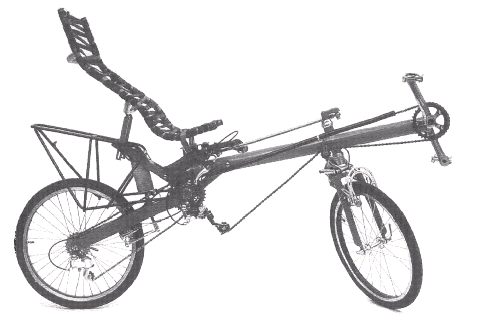At first we have to tell every recumbent novice a short tale.
Once upon a time on the street it was a cyclist, who bought a recumbent. This had a bottom bracket, which was far above the ground. So the cyclist had to pedal forwards or even upwards (Remember: Pedal upwards and arch the back to the bottom. - An inverse german proverb.) This stresses, like everybody well educated knows, the downward parts of the Musculi vastus laterales, vastus mediales and rectus femoris on a very special manner. The cyclist noticed this after a short time.
These three muscles are going down to the kneecap and are not enough trained by normal people (exceptions are mountaineers, runners etc.) to start directly a tour with a recumbent and go some days. That's why some hints:
- Start your training very slow and with low strain.
- In certain circumstances running training at the same time can work wonders (not for me).
- High pedaling frequency!!! This shortens the time of the highest strain to the kneecap during a rotation.
This means at the beginning a daily travel of 3-5 km, but flat way! Over months (!) you can increase the distance then, so that you can drive again steep mountains and sprints or with luggage after a half year. The more muscles you have, you shouldn't overrate yourself. I can tell some tales about it (I was a well-trained long standing swimmer and each-day cyclist.)
But it's wonderful to see the muscles growing (fantasy ist something beautiful.)
It's possible to raise mountains with a recumbent. This simple fact will be accepted very seldom by other people. You have to go the gradient differently: measure the optimal speed and the best gear at the bottom of the hill, and than go with a round footstep and like always with high frequency. If the upward gradient is long and steep enough one catches up most racing cyclists!
If one uses a short wheelbase recumbent then it's possible to drive tight curves after short training even for beginners. Thus there are no reductions opposite to a normal bike. And cutting the way during a traffic jam enjoys also with a recumbent. Long wheelbase recumbents are the true straight coursers partial with gigantic turning circles. Perfect as a bicycle for a long bike trip or for free handle driving - makes pedestrians around you mad.
|
Die hohe Geschwindigkeit eines Liegerades ist ja allgemein bekannt, aber nicht immer existent. Auch Liegeradler werden mal schlapp oder wie im Fall des Ostrads, ist das Rad auf Komfort ausgelegt. Man ist zwar langsamer als mit einem Renn-Liegerad, aber fährt wie in einer Sänfte. Diesbezüglich ist das lange Ostrad (Vorderrad vor dem Tretlager), mit mindestens dem doppelten Federweg wie das kurze, wohl die Referenz.
Das schnellere Fahren kommt vorallem durch die vergrößerte Muskelmasse, die an der Bewegung beteiligt ist zustande. Bestes Beispiel für diese Tatsache ist ein Bekannter von mir, der die Verstelleinrichtung der Rückenlehne beim Bergauffahren vollkommen abgeschert hatte (war damals auch nur Alu). Am Berg drückt man sich halt wortwörtlich brutal in die Lehne. Im Endeffekt kann man davon ausgehen, daß etwa 150-200% der normalen Leistung auf die Pedalen gebracht werden.
Der verringerte Luftwiderstand durch die kleinere Angriffsfläche kann durch die schlechteren (!) aerodynamischen Eigenschaften zunichte gemacht werden. Die tretenden Füße verwirbeln die anströmende Luft so stark, daß eine laminare Ströung um den Fahrer nicht zustande kommt.
Abhilfe schafft eine Teilverkleidung an der Front und schon selbst kleine aerodynamische Verkleidungen für die Pedale inklusive den Schuhen.
- In my experience the other road users pay much attention to such unusual vehicles. Thus nobody has to have fear because of this.
One introduces a curve with a bicycle with a short stearing to the opposite direction. But at a short wheelbase recumbent the bottom bracket is located in front of front wheel. So for outstanding ones it always looks like, as if you would like to drive into the other direction. That's important for and probably most remarkably if you drive slowly: pedestrians evade everytime to the wrong side. - Remember this!
Because of the low seating position you have to look for the traffic like every car driver - through the windows of the other cars.
|

